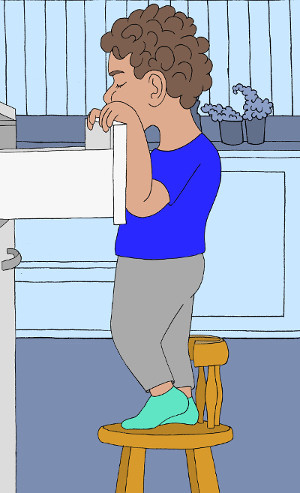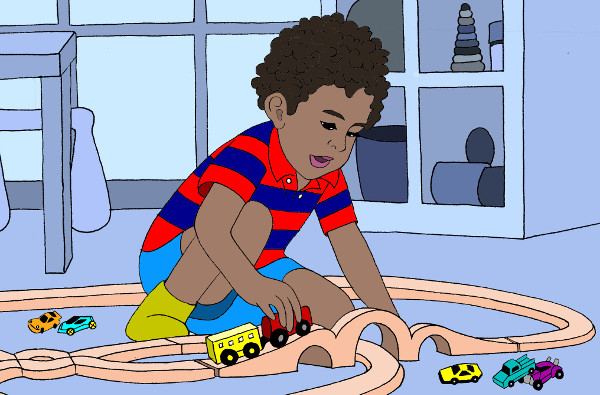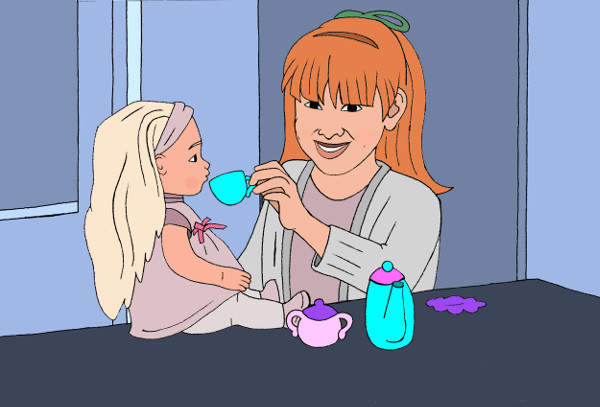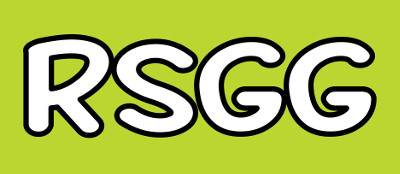“READY-SET-GO GENTLY” Quick View
Before we explain all the details, let’s get started with a quick summary. What is “READY-SET-GO GENTLY” and how can you put it into action today?
The basic idea is to give thought to every interaction that you have with your child. This is a specific thought, and it’s easy. It is along the lines of that simple phrase, READY-SET-GO! But we add the word GENTLY, because that is very important! Always be gentle with your child! He or she is so very precious, the most precious thing in your life.
So here is the first task: for every interaction with your child, begin to think in terms of: “READY-SET-GO GENTLY”!
During the course of each day, you will have many interactions with your child. Your child is always doing something. He is always on GO. Your child needs and wants your attention. It is important to respond often to your child. Think of your response as a “thing,” and call it a “GO GENTLY.”
What kinds of things can you respond to?
- You can respond to misbehavior.
- You can respond by freely giving attention when your child is being “good.”
- You can respond to requests.
- You can respond to conversation.
Your pattern of responses shapes your child's behavior.
Let's start by applying the READY-SET-GO GENTLY technique to misbehavior.
SITUATION 1: Imagine that your child is misbehaving. Imagine a 3-year-old little boy named Noah. Let's pretend he is your child. Noah has pulled a chair to the cabinet, and he is rummaging through your tool drawer, and you have told him 100 times to leave that drawer alone!

1. READY. You are paying at least some attention to your child, so you have noticed the situation. That is a good start. There is a little bit more to READY. Briefly think to yourself if you are READY to take action about this situation. Because you are going to make one calm request of your child, and once you make the request, you must respond. GENTLY, but you must respond.
Quite often, the response requires physical movement on your part. So... if you are on the phone or curled up on the couch and don't want to get up, then do not ask your child to stop. It is pointless, and your child will know it immediately!
You decide you are READY. (You don't like the thought of what little Noah might do with the hammer or screwdrivers, so you have to do something.)
2. SET. You give one “SET” request to your child. It does not matter how many times you have told the child the same thing before. Make THIS request once, calmly and clearly. In this example, you say, “Noah, please close the drawer and get down.”
3. GO GENTLY. You then “GO GENTLY” to respond to your child's response (or non-response). ALWAYS “GO GENTLY.” At the most basic, if the child does not comply, you gently enforce the request, AND, if the child does comply, you praise.
In this example, Noah ignores you and continues rummaging through the screwdrivers and pliers. You do not say anything more. You simply walk over, gently close the drawer, gently put Noah on the floor, and put the chair back where it belongs. That is your GO GENTLY. Then you might redirect Noah to something more appropriate to do.
Sounds pretty simple. You are thinking, “I do this.” Well of course you do! But if you are like most of us, you probably don't do it consistently, and you probably don't think of it as an actual “THING.” The point of this website is to give a name to good parenting skills. In this way, we can harness these skills more easily and consistently.
The heart of the technique is the ONE calm and clear SET request, followed up by the GO GENTLY.
What would you do if Noah complied with your request?
You still do a GO GENTLY! You praise Noah and thank him for doing as you asked. You help him find something else to do, and perhaps even play with him for a minute. Noah should get MORE attention from you for complying than he would for not complying.
But what if, when you GENTLY put Noah on the floor, he begins to kick and scream? (This is fairly likely to happen.) You must stay in “GO GENTLY” mode!
The best course of action is to completely ignore him, so that he does not get attention for that type of misbehavior. As we go through the website, we will explore many other ways to deal with that sort of thing. Fortunately, as you apply READY-SET-GO GENTLY every day, bad behavior will get less common over time.
Okay, sounds like wishful thinking. How would THAT work?
It works because there is another piece of READY-SET-GO GENTLY. In the course of each day, by taking thought, you will learn how to give your child POSITIVE attention for GOOD behavior! You will be giving MORE and BETTER attention for good behavior.
Your child wants your attention. She will do whatever it takes to get your attention! In general, “being bad” works well to get the parent’s attention. But YOU can change that!
SITUATION 2: Imagine that your child is doing something nice that is not annoying anyone.

Let’s imagine a little boy named Xavier, who is 4, running his toy cars along the floor in his play area. He is happy, and you have a zillion things to do. So, it is very easy to just leave Xavier alone. But let’s do a POSITIVE READY-SET-GO GENTLY.
1. READY. You are aware of Xavier, and you are pleased that he is playing so well. Very good! You ask yourself if you are READY to take a minute or so to give Xavier some positive attention. You decide: YES, this would be well worth the effort to encourage this good behavior.
2. SET. No particular “set” is required. The basic “set” is already done: Xavier has a place to play, and something that he enjoys playing with.
3. GO GENTLY. You step over to Xavier for just a minute, bend down, and comment on what he is doing. You might say, “Are your cars having a race?” And they might be, or they might be chasing bad guys; he will tell you about it, and you listen! And you say “I like that! Thank you for telling me about it.”
SITUATION 3: Your child makes a request, or wants to talk, and you respond.This is very common. A pleasant response is a quick and easy way to give POSITIVE attention.

Let’s imagine that you are doing something useful, such as looking in the refrigerator to see if you have any food. Five-year-old Olivia is playing nearby with her dolls. But then you hear, “Daddy? I don’t have any fresh fruit for my dolly.” Your first thought is to inwardly roll your eyes and think, “Right! We don’t have any fresh fruit for the real people in this house, either!”
But then you realize you need to respond.
1. READY. You were aware of Olivia, and you heard her question. Very good!
2. SET. Your only SET here is to take a millisecond to make sure you are using a pleasant tone of voice.
3. GO GENTLY. The refrigerator is just sitting there, and it doesn’t care what you do. But Olivia does care! So you say something like, “Olivia, you are right. Fruit is a healthy food. Maybe we could make some playdough fruit for your dollies! ”You spend 5 minutes getting Olivia started with the playdough. She is very happy with that attention!
Once you start looking for them, you will see that you have opportunities for hundreds of these POSITIVE-GO-GENTLYs in a day! You will seriously want to ignore many of them. But don’t! This is what life is about. Your child is important. She will only realize that she is important if she gets attention from you. When she does get her thoughts and words acknowledged by you, amazingly wonderful things happen inside her brain!
What is the flip side to doing a POSITIVE GO GENTLY? Well, if you ignore Olivia, she already knows that there are many ways to get your attention. She will come up with something. If misbehavior has worked in the past, well then... you can expect more misbehavior!
You have the power to make changes.
Your child does not.
You are the adult.
The READY-SET-GO GENTLY techniques will help you claim your own parenting skills! Then YOU can help your child grow and change. Soon, she will surprise you. She will learn to manage her own behavior.

